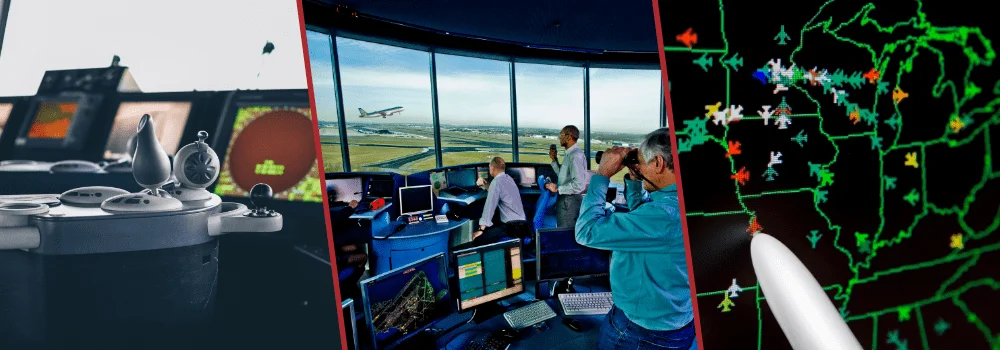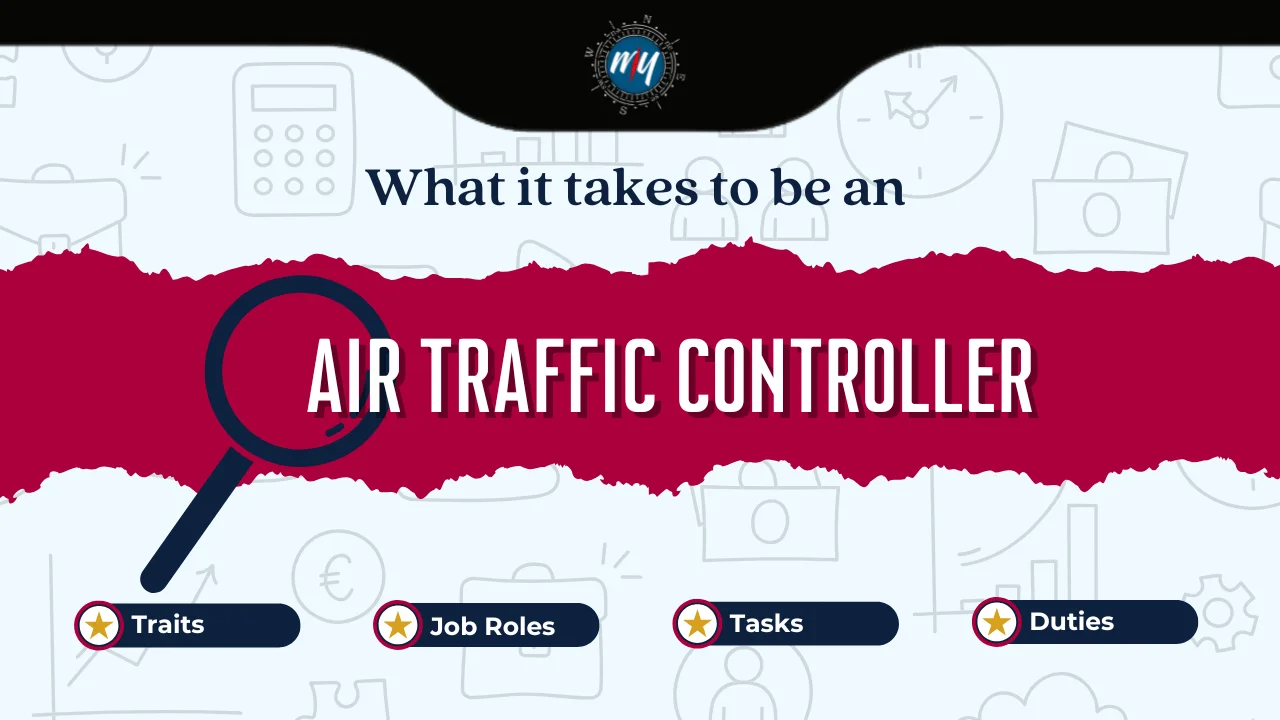How to Become an Air Traffic Controller?
Navigate the Skies: Your Journey to Becoming an Air Traffic Controller.

In this Career Outline

Introduction to Air Traffic Controller
“Guiding flights through the skies, ensuring safety and efficiency."
Have you ever looked up at the sky and wondered about the organized chaos of planes crisscrossing their flight paths? Behind this symphony of aviation, there are skilled professionals known as air traffic controllers who ensure the safety and efficiency of air travel. If you're intrigued by aviation and have a knack for coordination, becoming an air traffic controller might just be the career for you. Let's dive into what it takes to navigate the skies from the ground up.
Steps to Become an Air Traffic Controller:
Step-1
Obtain a high school diploma or equivalent. While a college degree is not always required, some positions may prefer candidates with aviation-related degrees or coursework.
Step-2
Enroll in and successfully complete an FAA-approved air traffic controller training program. These programs are typically offered by community colleges, technical schools, or directly by the FAA.
Step-3
Take and pass the Air Traffic Selection and Training (AT-SAT) exam. This test assesses your aptitude for air traffic control and is a requirement for employment by the FAA.
Step-4
Obtain and maintain medical clearance that meets FAA standards. You will also need to pass a security background check.
Step-5
If selected, attend the FAA Academy in Oklahoma City, where you will receive specialized training in air traffic control procedures and operations.
Step-6
Complete on-the-job training at an air traffic control facility. This phase allows you to apply what you've learned in a real-world setting under supervision.
Step-7
Obtain certification from the FAA upon successfully completing on-the-job training and passing practical exams. Continuously update your skills through ongoing training and education to maintain certification.
Eligibility Criteria
| Eligibility Criteria | Description |
|---|---|
| Eligibility | You must have at least 50% aggregate in your 12th grade from a recognized institution. |
| Educational Background | Only candidates with a science background are eligible for science degree programs. |
| Undergraduate Degree | Requires a B.Sc/B.Tech or a Diploma for becoming an Air Traffic Controller |
| Postgraduate Degree | An M.Tech in Aviation is advantageous for higher education. |
| Entrance Exams | Must achieve a valid score in entrance exams such as JEE-Main, KIITEE, SRMJEE, CEE, HITSEE, CET, etc. |
- To pursue a degree in science, one must have at least 50% aggregate in their 12th grade from a recognized institution under any board (PUC/CBSE/ICSE/ISC, etc.). The specific cut-off percentage can vary depending on the college's selection process.
- In order to qualify for admission, candidates should achieve a valid score in Entrance exams after 12th such as JEE-Main, KIITEE, SRMJEE, CEE, HITSEE, CET, etc.
- A prerequisite for becoming an Air Traffic Controller is obtaining a degree in B.Sc/B.Tech or a Diploma. This educational background is essential for entering this profession.
- Pursuing an M.Tech in Aviation can be advantageous for those seeking advanced degrees and deeper knowledge in the field.

Not eligible to pursue this career?
Find out different career options based on your current academic accomplishments. Enquire with our career experts and build a roadmap to your career success!
Tasks to perform as an Air Traffic Controller:
Knowledge & Skills Required
Air Traffic controllers require a diverse range of skills to excel in their positions. Below are the essential knowledge areas and skill sets required for success in this field:
| Knowledge Required | |
|---|---|
| Principles and procedures governing the safe and efficient movement of aircraft in airspace. | Characteristics and limitations of different types of aircraft, including performance metrics. |
| Understanding national and international aviation regulations and their implementation. | Protocols and techniques for effective communication with pilots and other air traffic control. |
| Understanding weather phenomena relevant to aviation and its impact on flight operations. | Familiarity with navigation aids, radar systems, and other technologies used for air traffic control. |
| Skills Required | |
|---|---|
| Analytical Skills | Adaptability |
| Decision-Making | Time Management |
| Problem-Solving | Technical Proficiency |

The Knowlegde and Skills don't intrigue you?
Your career may not align with your interests. Identify them and match with careers requiring those skills for faster growth and success!
Job roles offered for an Air Traffic Controller:
Once you qualify as an Air Traffic Controller, numerous career paths become available. You can engage in various projects within this field and explore diverse sectors.
Responsibilities include organizing air traffic, ensuring aircraft safety, providing weather and trajectory updates to pilots, and managing take-off and landing procedures. Safety is paramount as they assess conditions and liaise with stakeholders to ensure smooth commercial flight operations. They coordinate schedules, guide planes to terminals, and communicate critical information to pilots, especially during emergencies.
They create content for institutional communications, such as promotional materials, blog posts, and social media updates. Monitoring advertising metrics and maintaining digital content are also key aspects. This role demands strong communication skills, creativity, and knowledge of social media best practices, catering to a variety of organizations from nonprofits to businesses.
Responsible for monitoring aircraft once they leave airport airspace, En Route Controllers oversee traffic across continental air routes, typically away from terminals. Each center manages specific regions based on terrain and flight patterns. They direct aircraft paths to prevent collisions and enhance efficiency, guiding them until handover to destination approach controllers.
Collaborating closely with pilots, Aircraft Dispatchers ensure compliance with airline regulations, develop flight plans, monitor safety protocols, and track weather conditions. This role requires constant attention to flight schedules, often in dimly lit environments. It's a demanding job, with many professionals retiring around age 50 due to its inherent stress.

Not sure where you fit in?
With countless career options, choosing the right path can be tough. Analysis and guidance sessions help clarify what to study, pursue, and achieve.
Career opportunities in Air Traffic Controller:
Air Traffic Controller can opt for various fields of work in the companies listed below:
| Alstom | IndiGo | Spicejet |
| Air India | Jazz Aviation | First Student |
| Air Asia | Air India | CACI International Inc |
| Shipsy |
Colleges offering courses in Airfield Operations:
Here is the list of colleges offering the Best courses after 12th:
| University of Chandigarh, Chandigarh | Amity University, Noida |
| Birla Institute of Technology and Science, Hyderabad | University of Petroleum and Energy Studies, Dehradun |
| Indian Institute of Space Science and Technology, Thiruvananthapuram | Hindustan Institute of Technology and Science, Chennai |
| Nehru College Of Aeronautics & Applied Sciences, Coimbatore | India Institute of Technology, Mumbai |
| Manipal Academy of Higher Education, Manipal | Dayanand College of Engineering, Bangalore |
End Note
Becoming an air traffic controller requires dedication and a passion for aviation safety. If you're ready to embark on this exciting career journey, SetMyCareer is here to provide Career counselling and guidance along your path. Connect with our experts to explore how you can turn your passion for aviation into a rewarding profession.
In this Career Outline
You don't fit in as an Air Traffic Controller?
Find out your best suitable career by booking an appointment with our experts
Book nowGet In Touch
No. 14/595, 1st Floor, Nanjappa Reddy Layout, Koramangala 8th Block, Bangalore 560095






